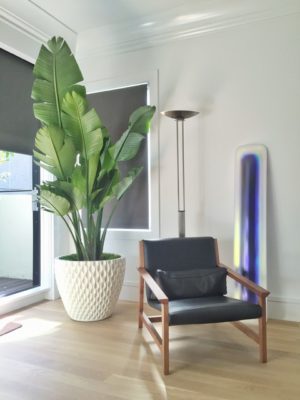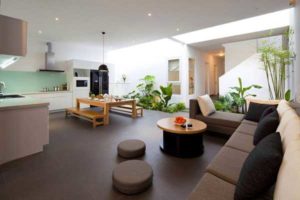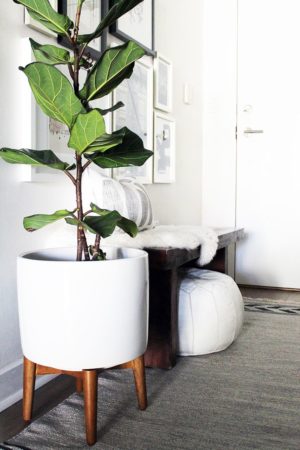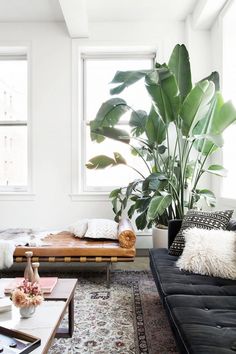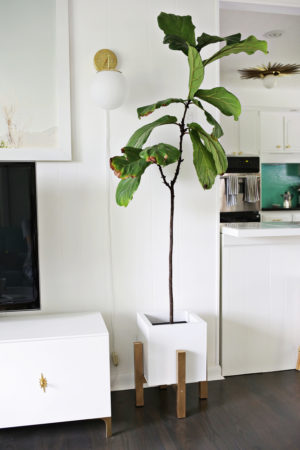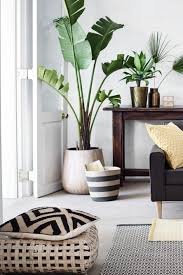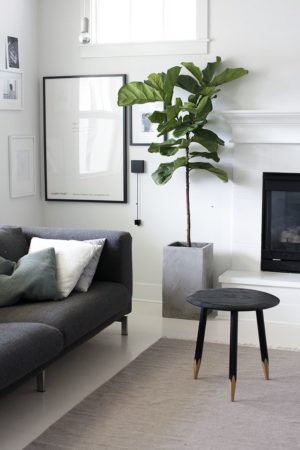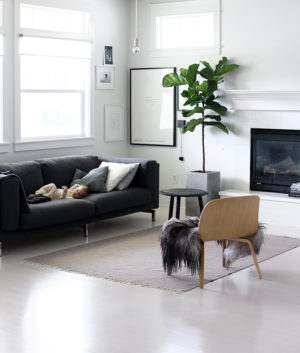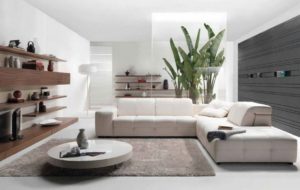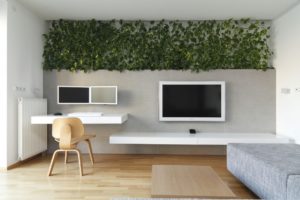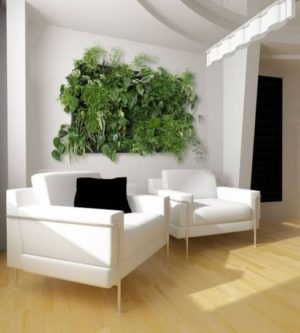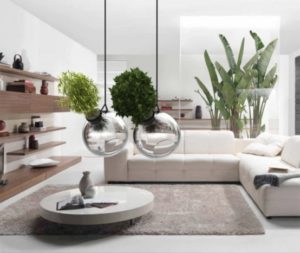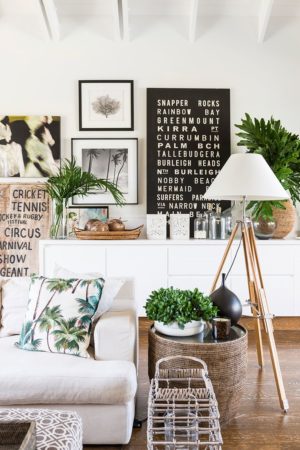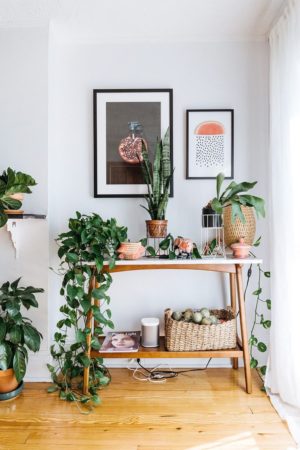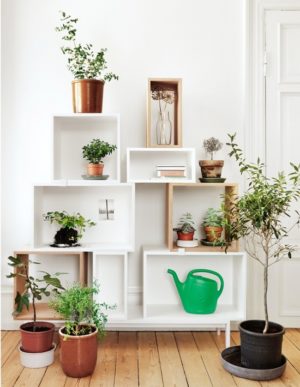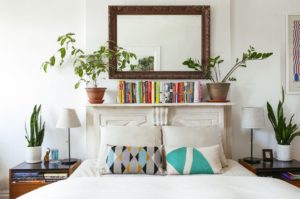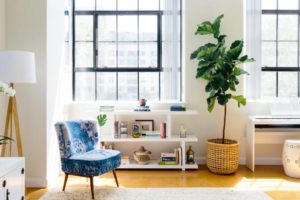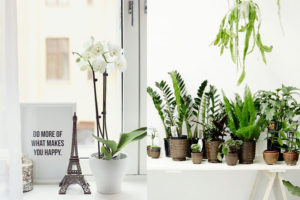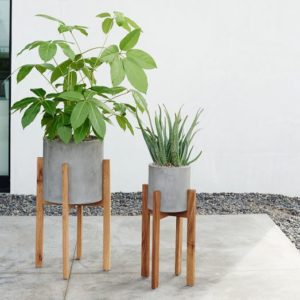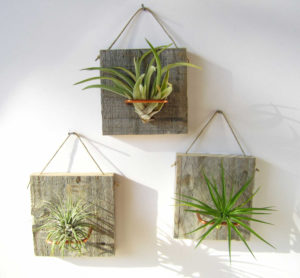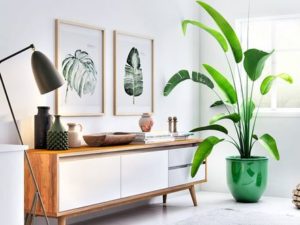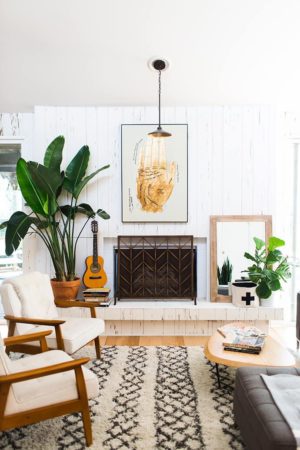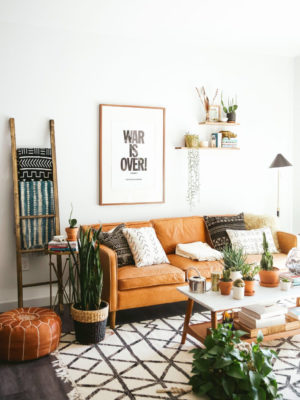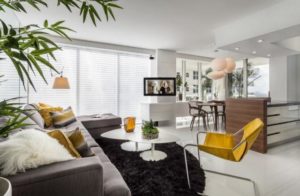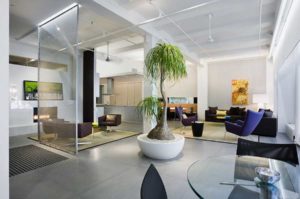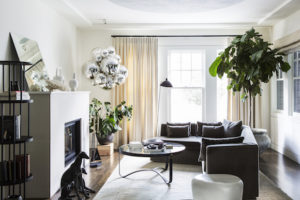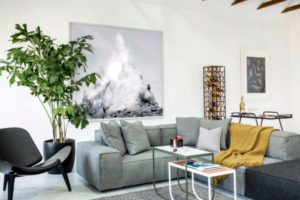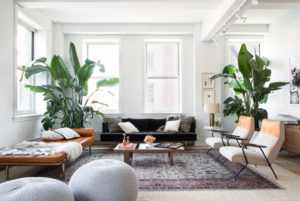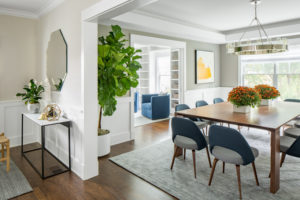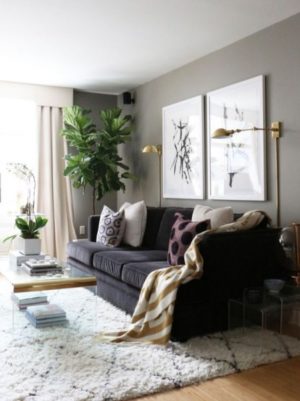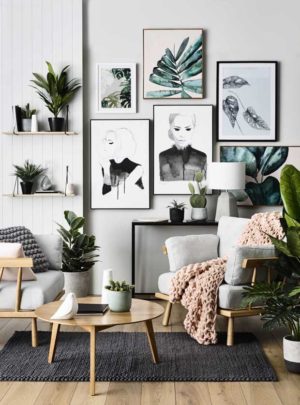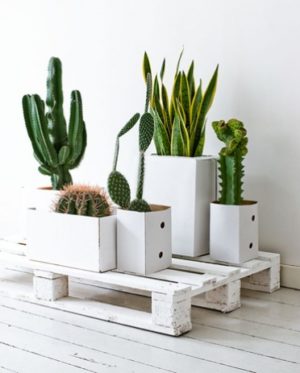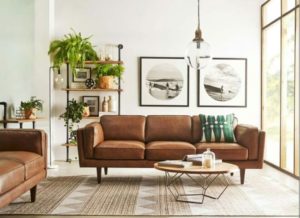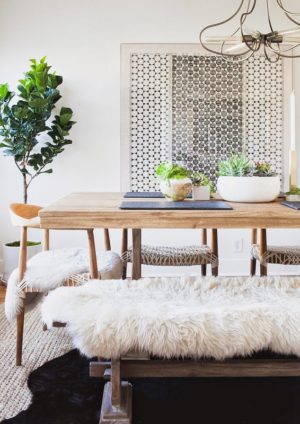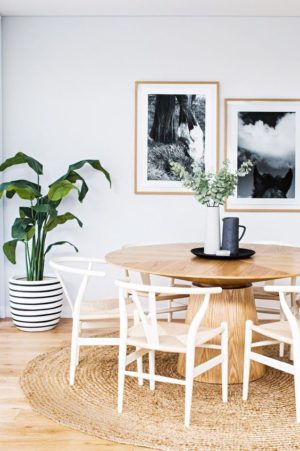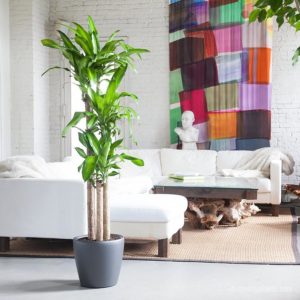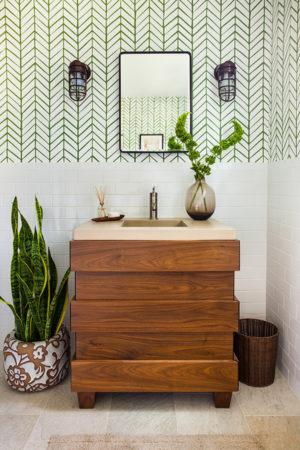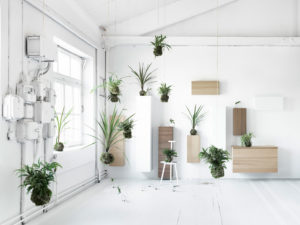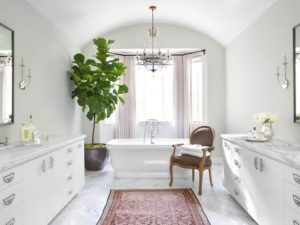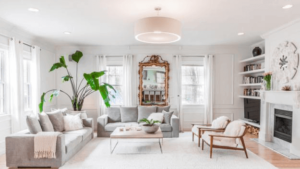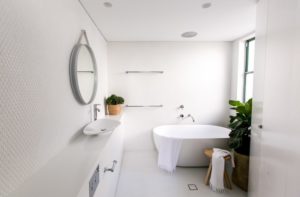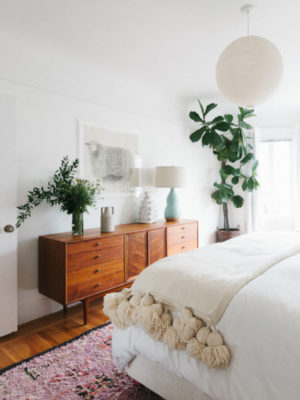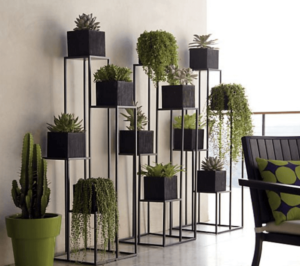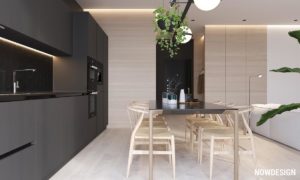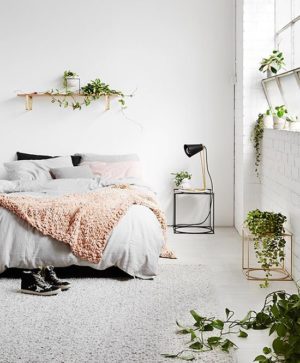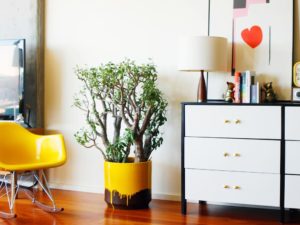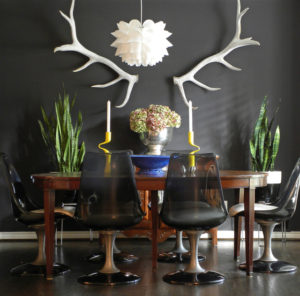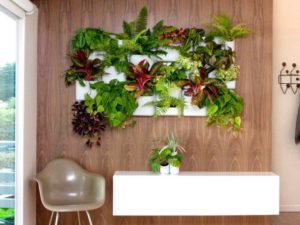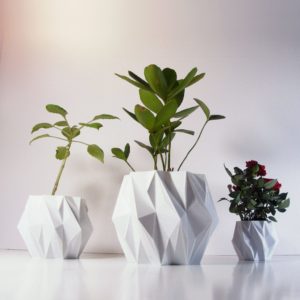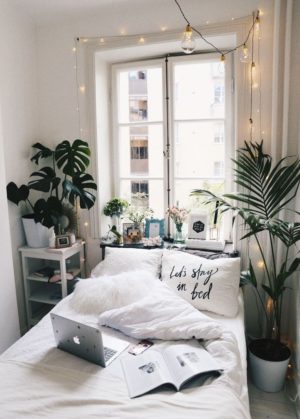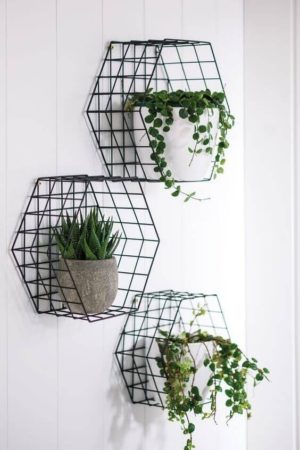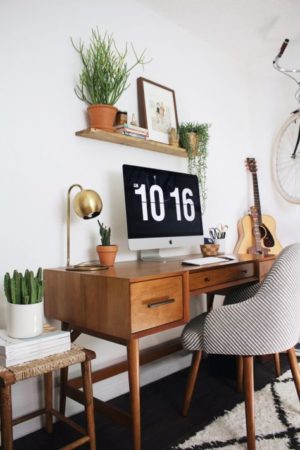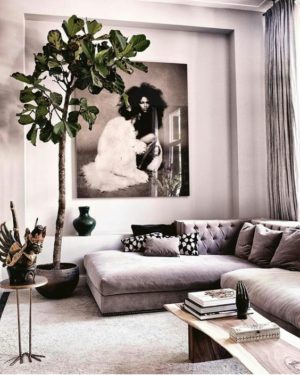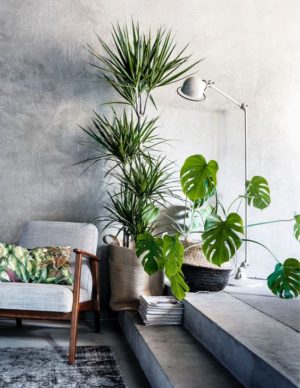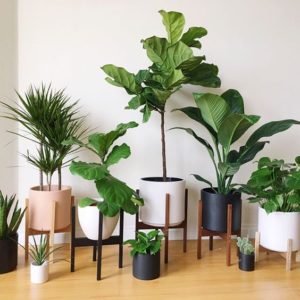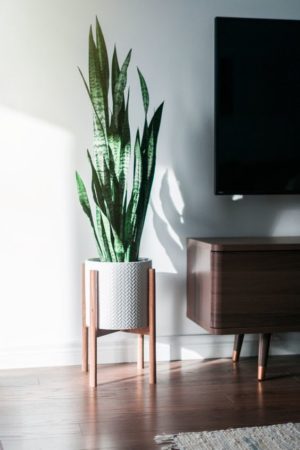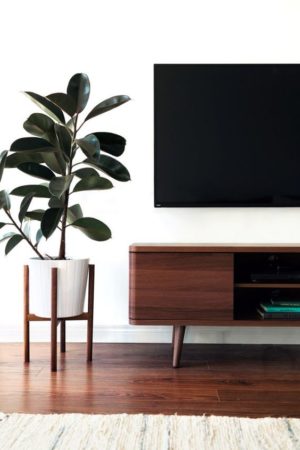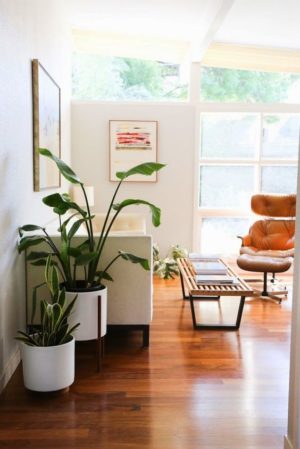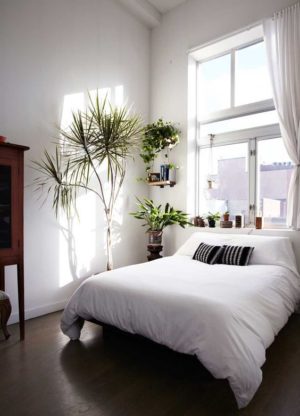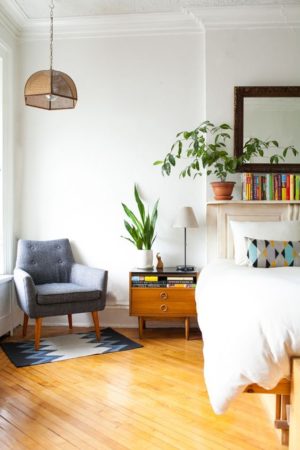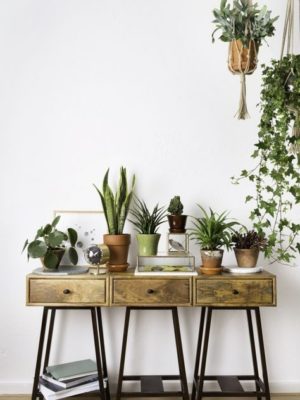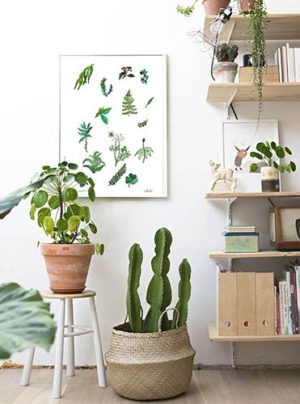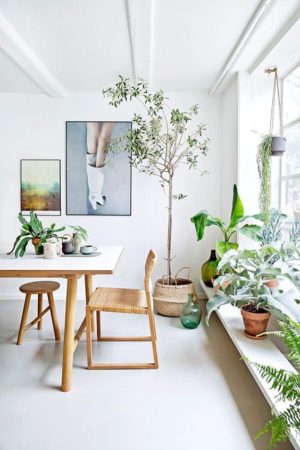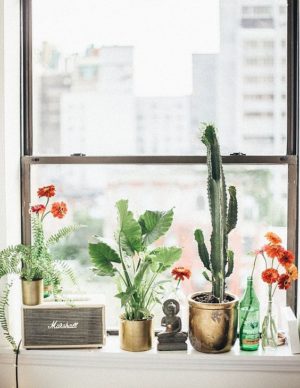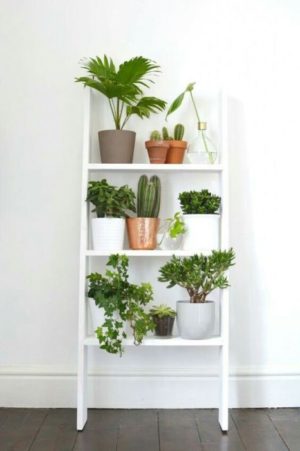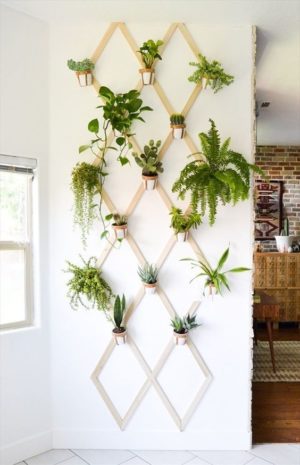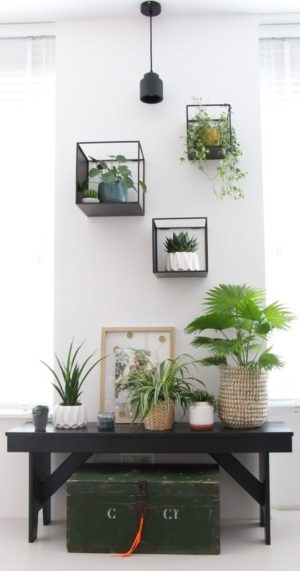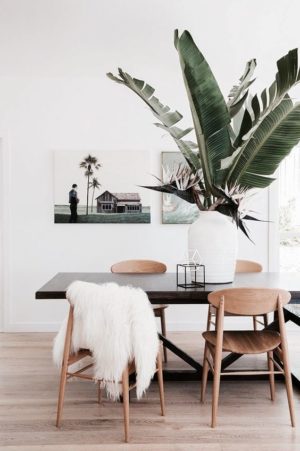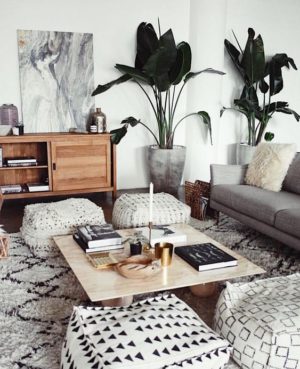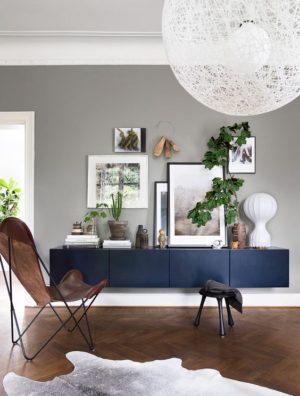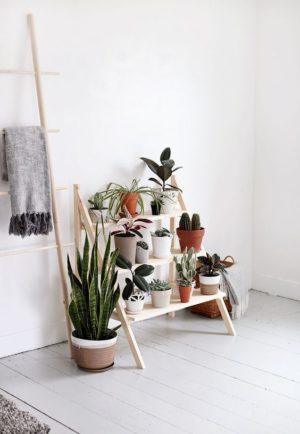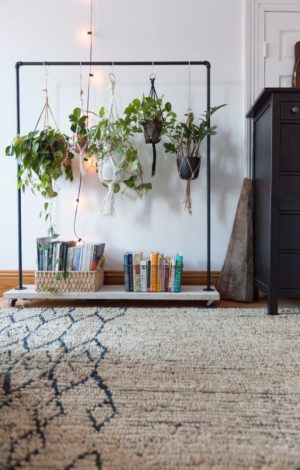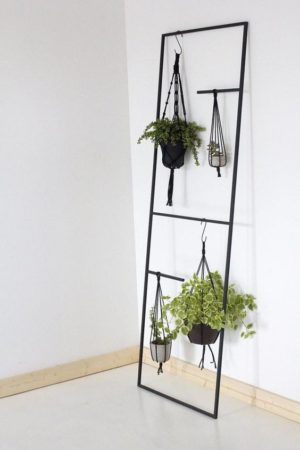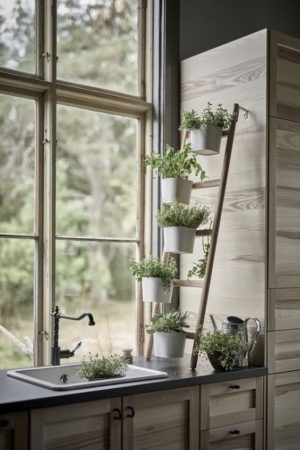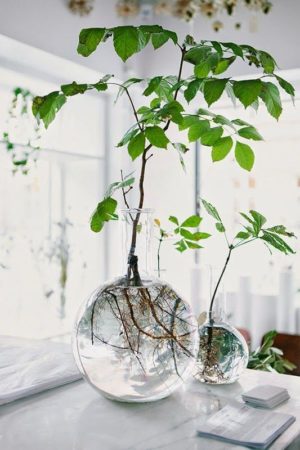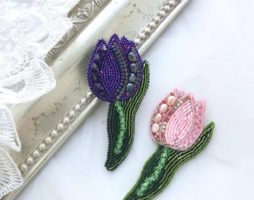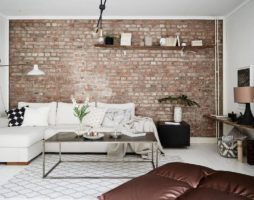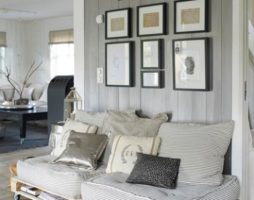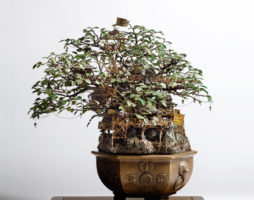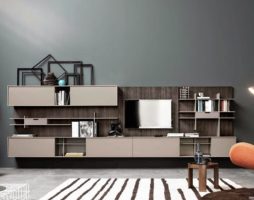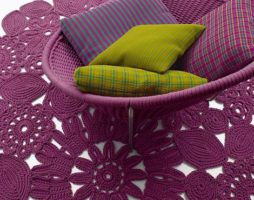2018 broke the fashion interior value scale. Now - all of a sudden! - it is announced that a house without greenery is the last century, that it is old and inexpressive. Suddenly it turned out that interior design without plants looks unfinished and faceless.
- Myths about indoor plants
- The triumphant return of ficus - a new botany in the interior
- Fashionable aesthetics of the stone jungle - the combination of loft and living plants
- Warm to cold: indoor flowers in a high-tech interior
- Fresh flowers in art deco decorations
- Heroes of ecodesign - all directions of country style
- Scandinavian purity of lines
- A little bit of floral affectation in shabby chic
- Interior classics and phytodesign: the embodiment of decency
- Maximalism in everything or the revival of genuine luxury
- I raised you - I will eat you: about beautiful and tasty phytodesign
- Plant hedges in the interior
- How not to fall into slavery?
- What to do incompetent?
- Balcony landscaping
- What surprised us designers in 2018
- Photo gallery - indoor plants in the interior
- Video
It lacks fireworks of colors, grooming, originality, it looks naked and uninhabited. Everything is known in comparison: indeed, a few living green plants in the interior of the apartment transform the look of the room so much that if you remove them, a vacuum is created that cannot be filled even with very beautiful things.
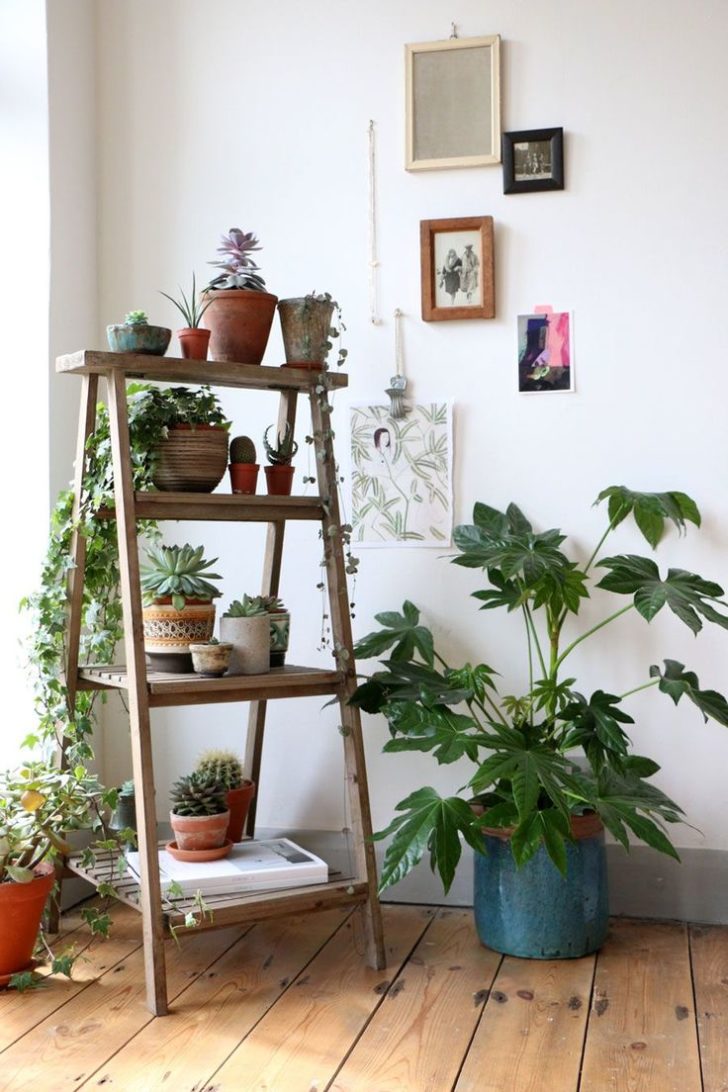
Indoor plants transform the interior
This news inspired some to go to flower shops, others plunged into panic - after all, there are people in whose hands even a cactus will wither. Let's reassure right away: there are acceptable design options for everyone, in extreme cases, you can buy artificial plants for the interior.
But where to start? Certainly not from buying flowers!
Until then, you will have to:
- find out if the vegetation in the house is useful;
- decide which corners of the apartment lack green areas and what role they can play in zoning and visual transformation of space;
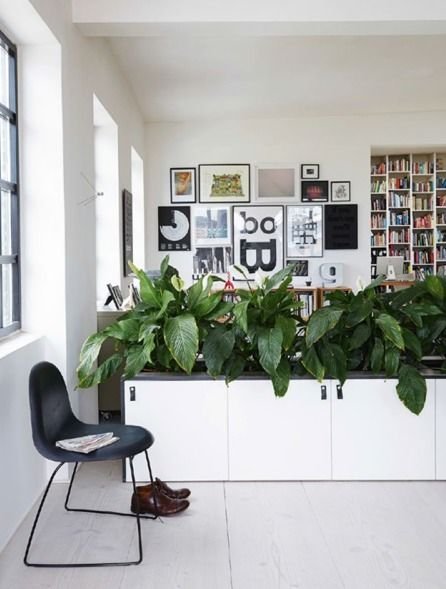
Indoor plants can participate in the zoning of the room
- to estimate whether it is possible to combine the beautiful with the useful - with the edible, for example;
- decide in what frame live accessories will appear - get acquainted with the types of pots, planters, shelves, jardinieres, florariums;
- recover from the shock of discovering what unusual interior gardening options were invented by designers (oh, believe me, they have nothing to do with geraniums on the window);
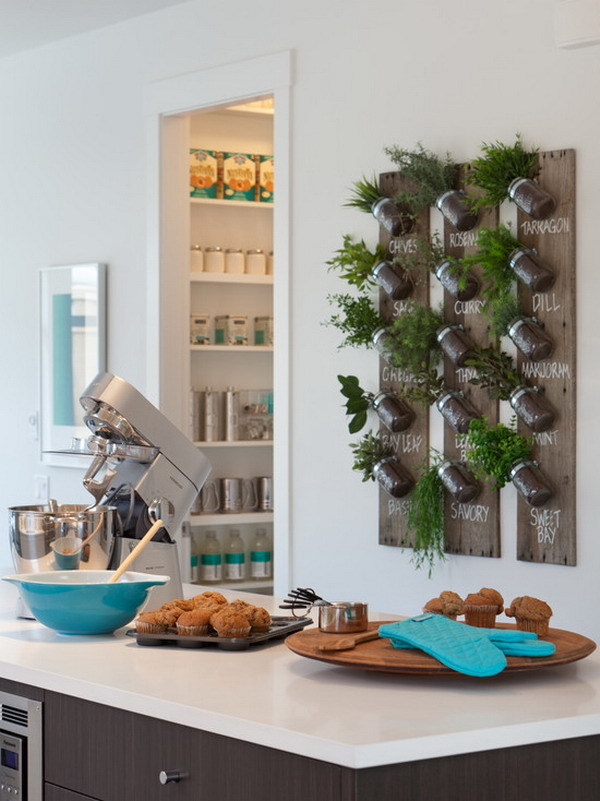
Consider unusual landscaping options
- breathe a sigh of relief when you learn about the existence of closed automated plant life support systems in the interior;
- grab your heart (or your wallet) after finding out how much such systems cost;
- assess the degree of illumination, humidity, temperature;
- develop a project for placing plants in the interior of the house;
- and only after that choose the plants themselves for the interior - with the help of a designer or a flower seller, taking into account the architectural style and your own inclination (or not) to floriculture.
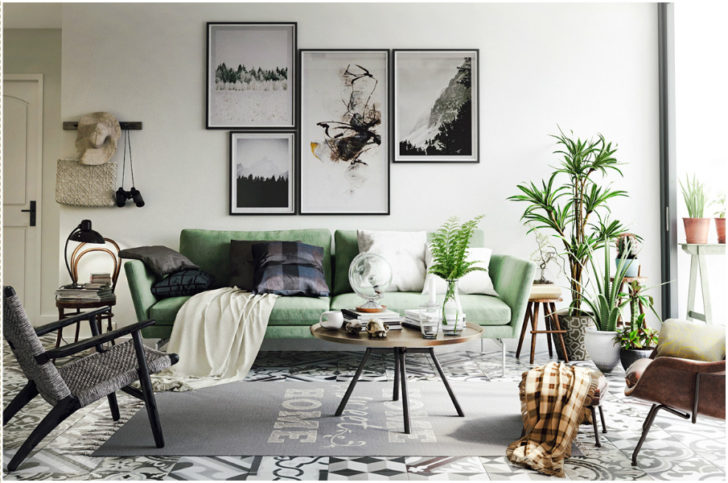
Indoor plants should be in harmony with the style of the interior
It is reassuring that there is some joke in such a serious algorithm. In the end, even accidentally turned up flowers, geranium or ficus, will bring the forgotten cuteness of the good old traditions into the design and will be regarded by aesthetes as a fashionable touch. But do we want more?
So, put aside fears - and forward, into the exploration of the green world of modern design!
back to index ↑Myths about indoor plants
Superstitions about indoor flowers that drive away good luck are contradictory, but arguing with them is a thankless task. True or not, ivy has a bad reputation for persecuting men. It is believed that ivy prevents a lonely young lady from bringing a man into the house, and even more so from keeping him. At the same time, in narrow circles of magicians and soothsayers, they note the ability of ivy to extinguish energy emissions - both good and bad. Conclusion: after a scandalous parting with a lover, ivy is just the pill that will help you forget, forgive and calm down.
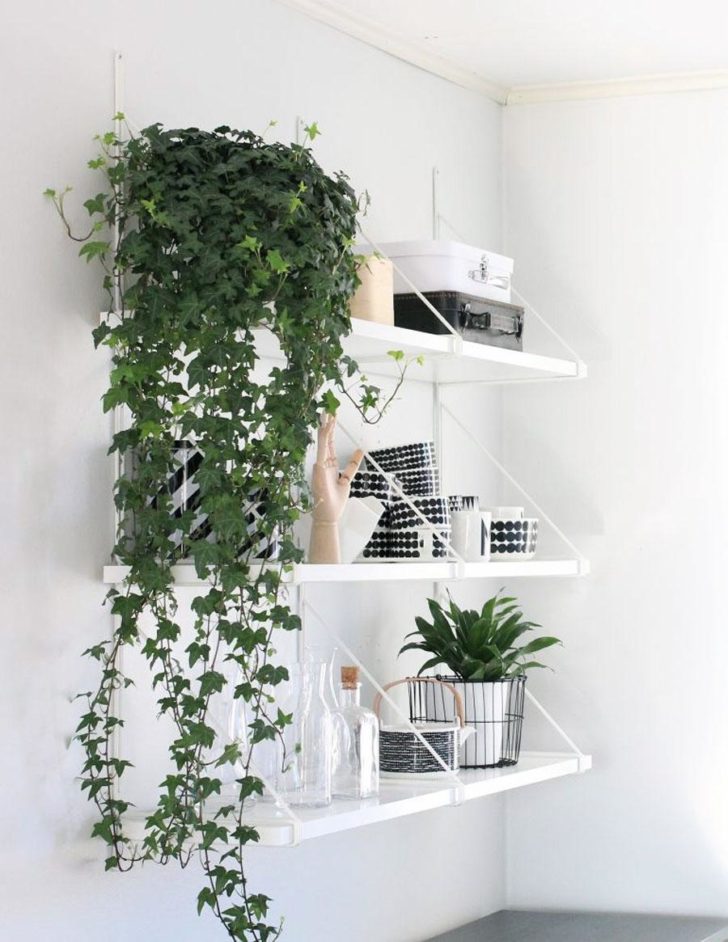
There is talk of ivy's ability to dampen energy emissions, both good and bad.
By the way, following ivy, its specific properties began to be attributed to other climbing plants in a residential building. It is somehow a pity to abandon such a decorative category of indoor flowers because of unsubstantiated accusations, especially since ivy is clearly in trend.
The orchid suffers practically for nothing - it was credited with a suffocating effect due to the mere appearance of the roots that supposedly entangle the sleeping person.
All the arguments about plants emitting carbon dioxide at night are true. However, their presence in the bedroom is critical only if the room is hermetically sealed and not ventilated. To be honest, in such conditions and without flowers it will be stuffy.
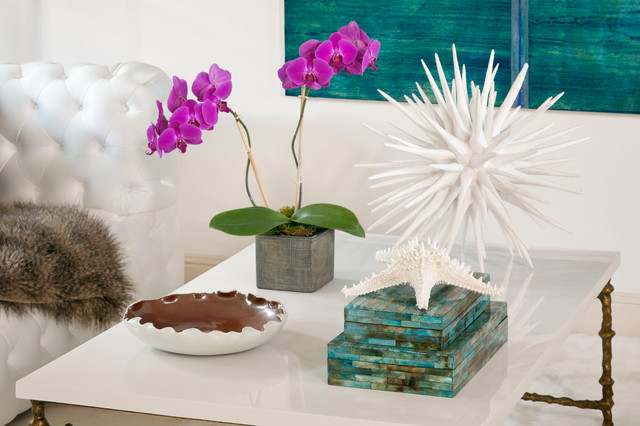
Air the rooms with flowers
The version that strongly smelling flowers interfere with night rest seems more serious. Indeed, from the intoxicating aroma, the head can ache during the day, although all this is very individual.
For allergy sufferers, any contact with pollen is undesirable; it is better for them to choose indoor flowers with decorative leaves. However, the soil also poses a danger, spreading spores of fungi. This does not mean that you have to abandon the home greenhouse: you can, for example, cultivate green lawns on a hydroponic artificial irrigation system or use artificial flowers that skillfully imitate natural ones.
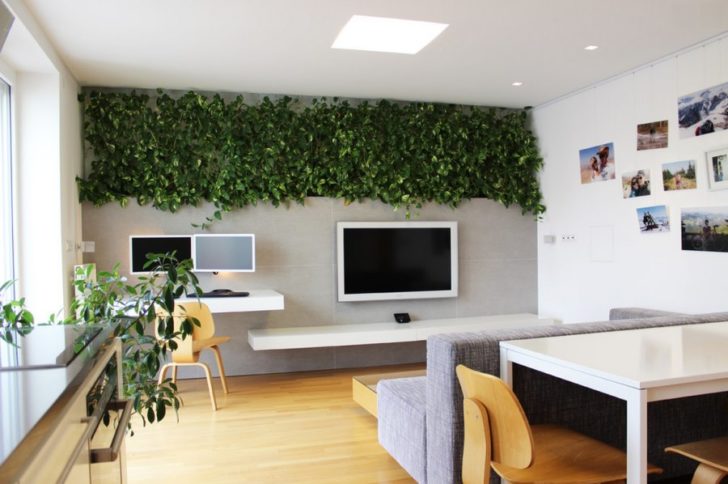
For allergy sufferers, plants on a hydroponic system are suitable.
Poisonous plants pose a real threat and should be used with great care. Poisonous greens include: aglaonema, anthurium, alocasia, croton, monstera, spurge, oleander, pachypodium, fatsia, dieffenbachia - their photos must be carefully studied and remembered.
Surprisingly, almost all of them turned out to be the favorites of designers in 2018 - these plants are so picturesque! Do not refuse such beauty? In extreme cases, they can be placed in the upper tier of landscaping - it's safer.
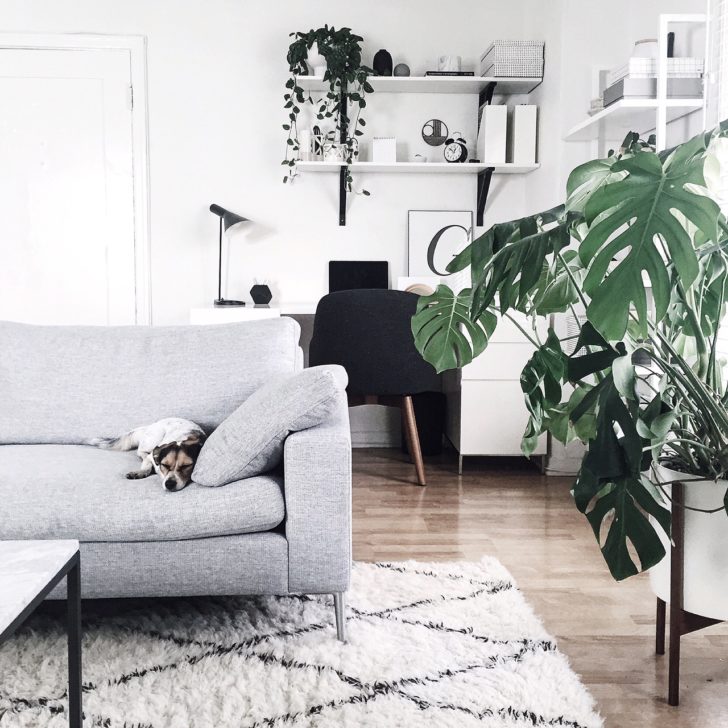
Picturesque monstera in the interior
It remains to be added that, with very rare exceptions, plants in the interior of a residential building play the role of an island of nature that refreshes and moisturizes the air, soothes, and pleases the eye.
back to index ↑The triumphant return of ficus - a new botany in the interior
How did designers turn to indoor plants in 2018? This became a logical continuation of the idea of ecological phytodesign of the interior, which the Japanese and Scandinavians have never changed. The need for natural materials, natural forms and islands of nature inevitably resulted in an interest in houseplants and the search for their new role in home decoration.
The revolutionary direction was called "new botany". It has penetrated the interior of all existing styles, from urban to country, from minimalism to classics.
The mission of indoor plants is to harmonize the design of the house and bring a new melody to it.
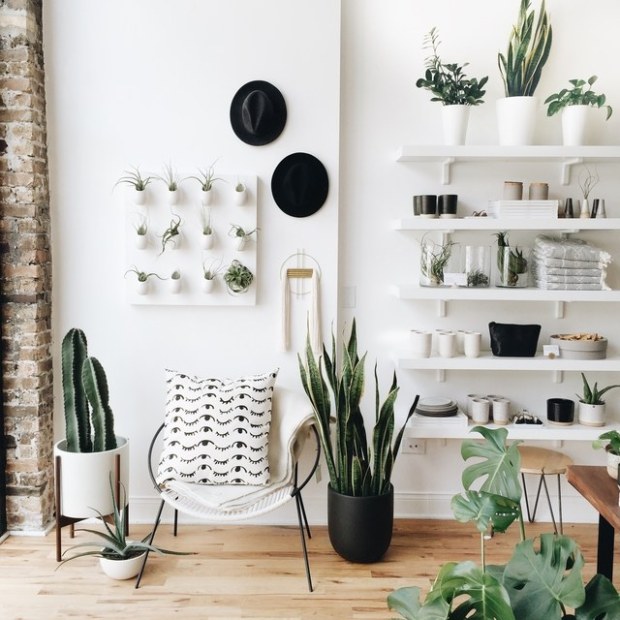
Indoor plants will bring a fresh note to the interior
How necessary are indoor plants in the interior of an apartment decorated in a certain style, and which ones should be preferred?
back to index ↑Fashionable aesthetics of the stone jungle - the combination of loft and living plants
What does a ficus do in a loft interior? No, he's not blocking a hole in the wall!
A large plant in an urban interior plays the same role as a red leather sofa or a picture in a gilded frame - working "in contrast", it emphasizes the picturesque imperfections of industrial textures.
Well-groomed greenery against the background of concrete or brickwork enhances the shocking effect. For loft apartments, voluminous plants are selected, with expressive large leaves, in stone tubs or metal containers adapted for them (photo).
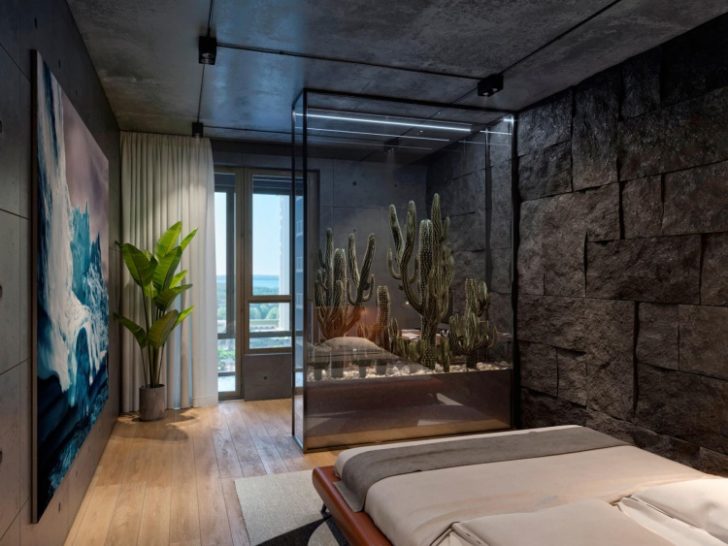
Plants with large leaves are suitable for loft apartments
A daring technique for landscaping a loft is an imitation of an industrial greenhouse. Industrial lattice glazing, irrigation pipes and lush greenery in an enclosed space develop style ideas in an unexpected way.
Plants in flasks, transparent balls, in glass jars - these trendy florariums seem to be created to create local green accents in an urban interior.
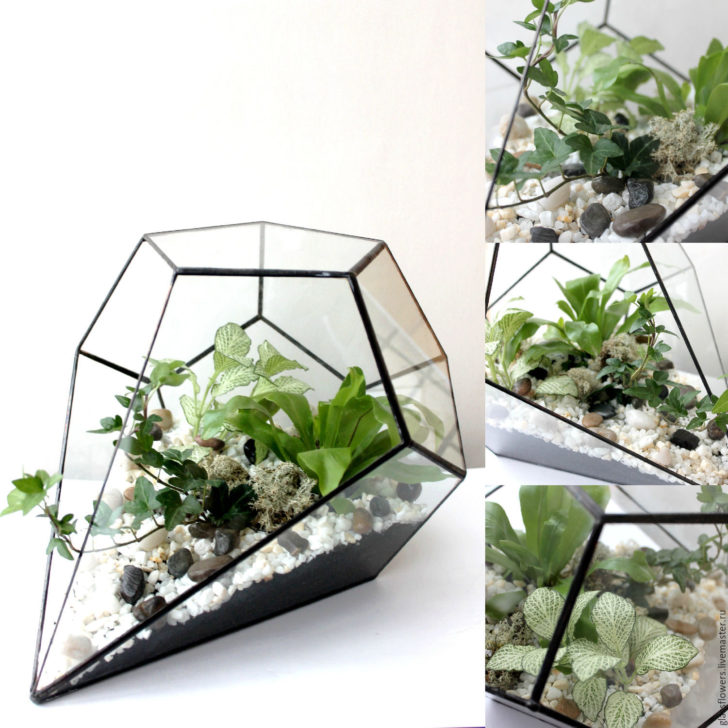
Florariums are ideal for loft-style interiors
Warm to cold: indoor flowers in a high-tech interior
What would greenhouses on a space station look like? Probably the same as plants in high-tech apartment design projects.
First of all, these are lawns, horizontal and vertical. By the way, a vertical lawn is a complex engineering structure with an automatic watering system, which conceptually fully corresponds to the principles of high-tech style.
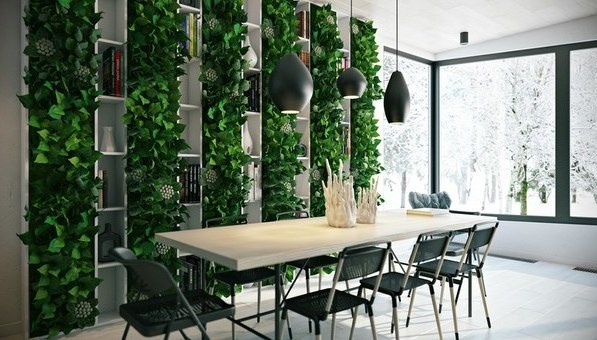
Vertical gardening for a high-tech interior
Florariums, miniature and voluminous, are semi-closed ecosystems with a microclimate. They are picturesque and in perfect harmony with the glossy surfaces of the interior.
An element of vintage - ceiling plants growing "upside down". This is something that immeasurably surprises every day, which is impossible to get used to. But it is in high-tech that such landscaping of the interior seems quite logical.
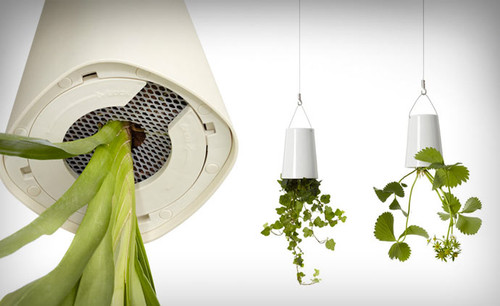
Creative plants growing upside down
Fresh flowers in art deco decorations
Among the styles that have historical and ethnic roots, Art Deco stands out for its artificiality. All design techniques are nothing more than an imitation of the classical style, sometimes with elements of Empire and antiquity, but what a refined and strict styling! Plants have always been used in this interior, but they were chosen very carefully. Preference is given to the decorative shape of the leaves and the strict graphics of the silhouette.
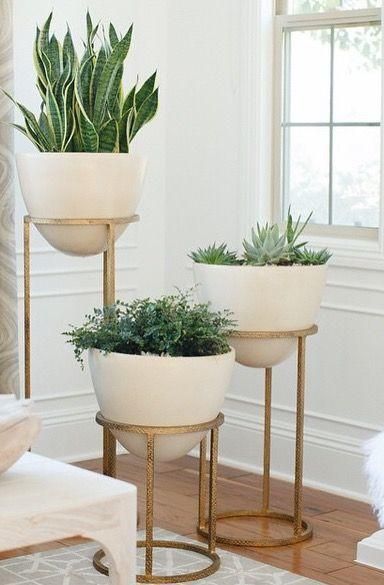
Composition of indoor plants in art deco style
Heroes of ecodesign - all directions of country style
What did the fashion trend of "new botany" give to those country style, in which flowers and green plants were traditionally present? First of all, he raised the status of country direction. Secondly, the developments of the new wave gave interior designers fresh ideas and magnificent flower accessories - racks, whatnots, jardinieres, planters.
One could say with a slight exaggeration: how many countries, so many country style trends. Consider the techniques for using indoor flowers and plants in the interior of urban apartments with a rural design.
Flowers and scents of Provence
In the French provincial Provence style, flowering crops are in the lead:
- roses;
- violets;
- geranium;
- oleander;
- bulbous - tulips, hyacinths, daffodils, crocuses;
- mini-lawns in pots of cereals, lavender, herbs.
- as well as evergreen laurel, ficus, etc.
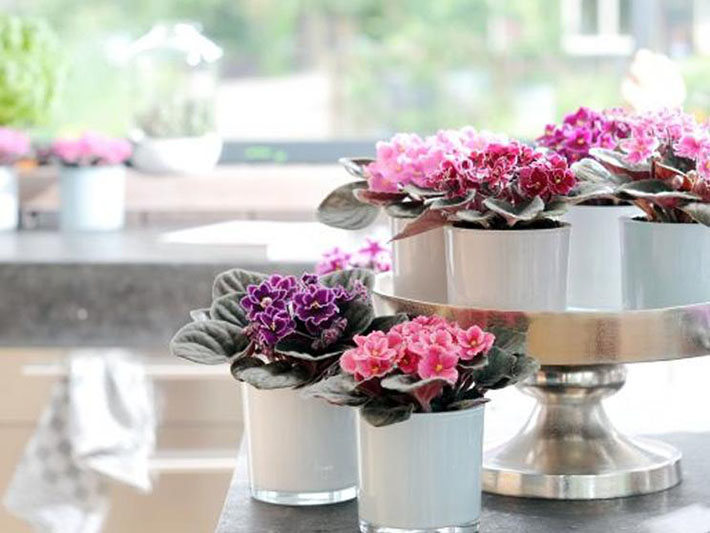
Violets will perfectly fit into a romantic interior in Provence style.
A feature of Provence is the adaptation of a variety of containers as flower pots and ingenuity in their handicraft decoration. They are painted, aged, covered with craquelure and patina.
An important element is the abundance of shelves, jardinieres, whatnots and improvised pedestals for plants. In Provence, it is customary to put flower pots on the windowsill, on the kitchen sink or dining table.
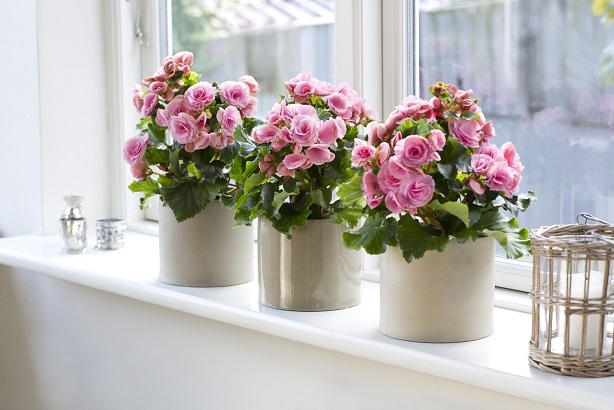
In Provence, it is customary to put flower pots on the windowsill
american country
Least of all, new landscaping ideas touched American country, this style is incredibly conservative. A few wooden or ceramic plant pots are more than enough to liven up a farmhouse interior.

Several plants in ceramic pots will decorate the interior in country style
Japanese mini gardens
In the tradition of the Japanese interior - admiring plants, stones, wood. All three elements are present in living plant compositions in the Japanese style.
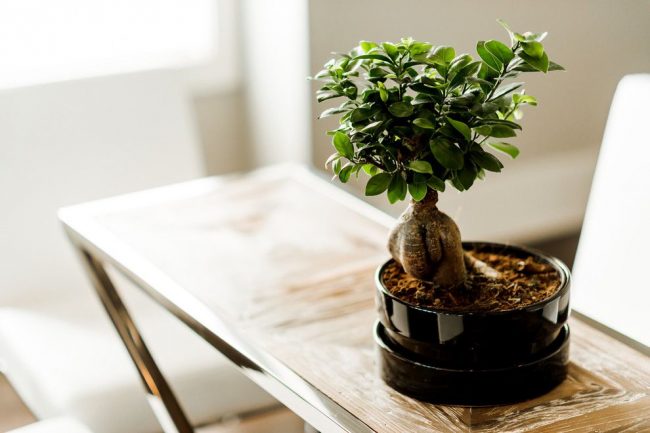
Bonsai for a laconic Japanese-style interior
Plants in the Japanese interior are never presented without a frame. A wooden rack, a clay or wooden planter, stones and sand covering the ground, a lone bonsai tree or a plant composition - all this makes up a single whole.
Mediterranean style: blooming coast
The sunny Mediterranean interior with elements of rough antiquity is filled with a special charm when southern flowers and plants settle in it - indoor cypresses, papyrus, oleander, ivy, roses, etc.
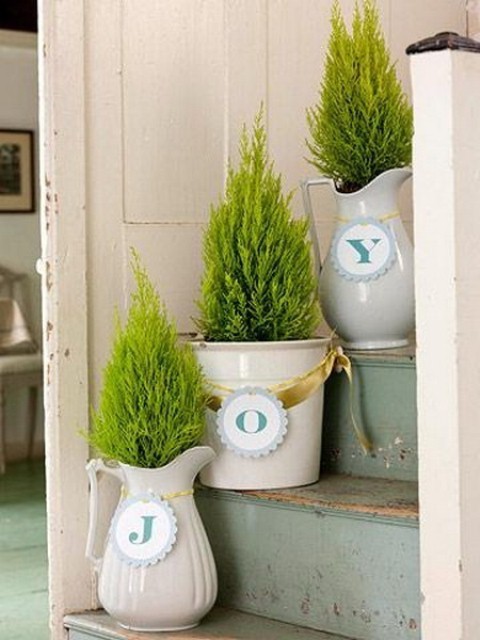
indoor cypresses
Ceramics, stone, mosaic, wood, metal, fabrics and ropes are used in the design of the cache-pot.
back to index ↑Scandinavian purity of lines
In a Scandinavian interior, indoor plants carry the same burden as large designer accessories: they give minimalism an elitist charm. Each plant is "served" so that it is the center of attention.
How did the legislators in the field of design enrich this style? Lawns have come into the interior. They were used in the Scandinavian style before, but pointwise. Now the wall, the podium, some other significant spaces are given to the lawn. In continuous landscaping, cereals, moss, ampelous plants and low leafy plants are used.
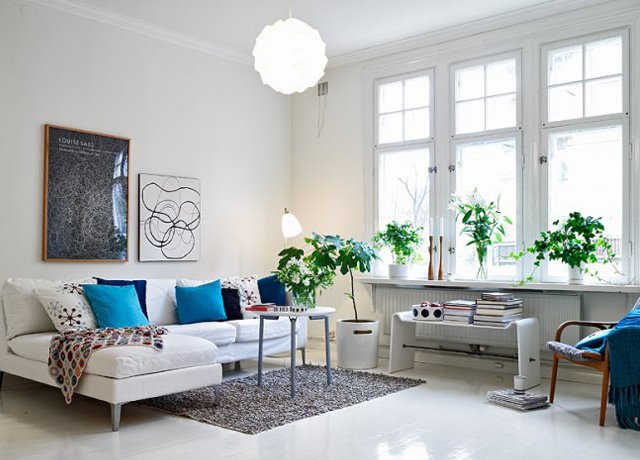
Interior landscaping in Scandinavian style
It was in the Scandinavian style that vertical hanging gardens were first used. They are framed like a picture. They create a picturesque carpet from stems and leaves of different textures. Embed in niches. They replace the piers.
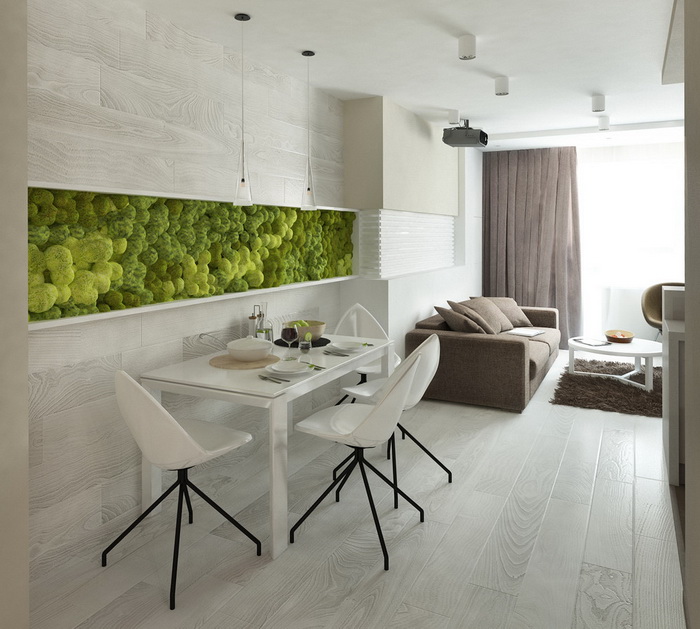
Vertical flower bed in a Scandinavian interior
Spectacularly and organically complement the decor with florariums - inventive mini-greenhouses for dwarf plants.
An extravagant way of presenting plants is ampelous flowers hanging from the ceiling. And a completely surreal example of interior phytodesign - inverted pots with stems growing down.
back to index ↑A little bit of floral affectation in shabby chic
Ladies' shabby chic has never sought to decorate itself with flower pots, replacing live decor with lace and painting. Now this interior is decorated with roses, ivy, dracaena, oleander, etc. Blooming plants look especially romantic in the interior dusted with old times.
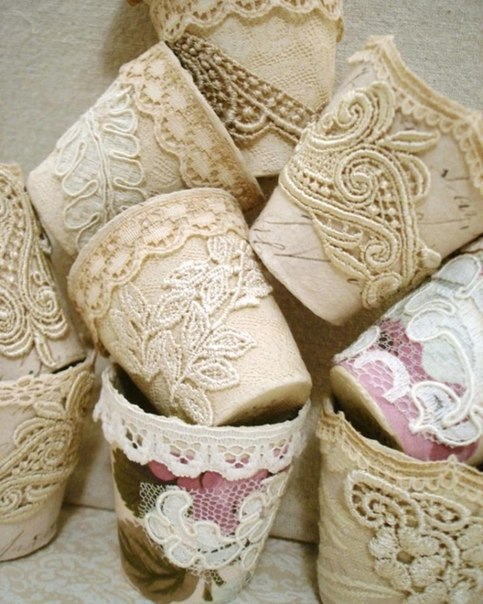
Shabby chic flower pot decor
Interior classics and phytodesign: the embodiment of decency
The classic interior and its lightweight version - neoclassic - never really needed support from the floral decor. Now the current classic design involves the creation of a green island in the room from several plants on jardinieres, shelves or in floor planters.

Green islands in a classic interior
The entrance hall can meet guests with a luxurious palm tree in tubs, and in the living room, behind the back of the sofa, an unusual carpet will unfold - a vertical panel of flowering and deciduous plants.The new face of the classic interior is defined by lively green accents.
back to index ↑Maximalism in everything or the revival of genuine luxury
The modern interior of apartments, “brought up” on ascetic minimalism, missed luxury. This is noticeable in many trends - the return of velvet, damask ornament and lacquered polishing of expensive furniture, in juicy terracotta colors that replaced marsala, in relation to indoor plants, which have moved from episodic decor to a powerful, conceptual architectural form.
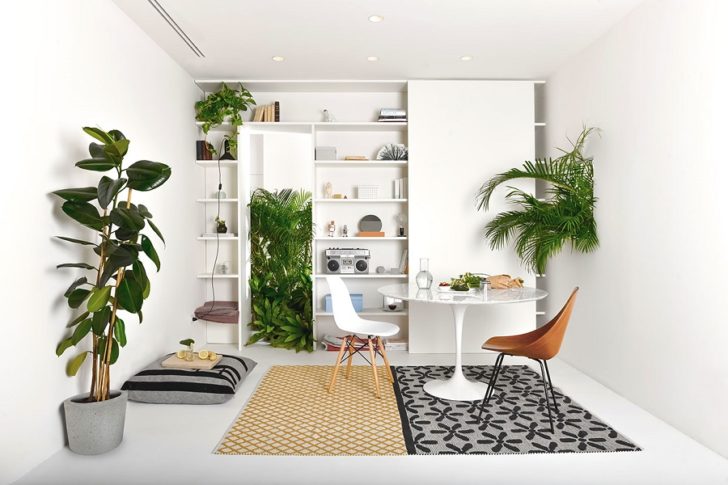
A green oasis of indoor plants
Green areas in the apartment are designed comprehensively. Their role in zoning is thought out, lighting and humidity are checked for compliance, care is planned. They have become larger, more creative, more diverse.
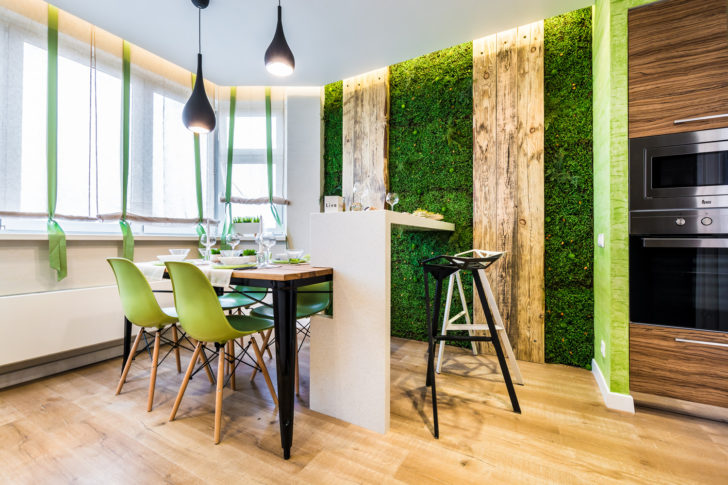
Vertical green area in the apartment
At the same time, some irony and lack of self-admiration are inherent in a good modern interior. Example? Yes, here it is, in front of you - a little mischief in the kitchen, and not only.
back to index ↑I raised you - I will eat you: about beautiful and tasty phytodesign
It turns out that nothing human is alien to high fashion. She gave her blessing - you can't say otherwise - the creation of garden greenhouses, the placement of edible indoor plants in the interior of a city house. Moreover, for many, this activity has become an incredibly contagious hobby, and amateur designers are in the process of finding new “chips”.
Let's take a look at the kitchen and dining room first. All kinds of jars, buckets, as well as quite solid planters (depending on the style of the interior) are densely planted with parsley, watercress, arugula, mustard, basil and other spicy herbs. No one seeks to bring it to a state of biological ripeness. Grown up - cut off - planted a new one.
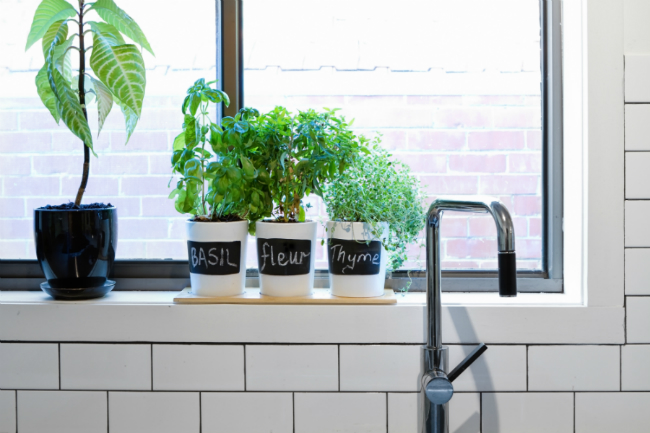
Spicy herbs are appropriate in the interior of the kitchen
If opportunities allow, you can arrange a phytopano above the dining area.
Another option for selecting plants is “guests from the dacha”. At the end of the summer season, bushes of dwarf tomatoes and peppers move into the kitchen (chili looks especially nice). Of course, they can be grown immediately in a flower pot, bypassing garden beds.
Resourceful housewives found out that lettuce and Chinese cabbage stalks, the leftover greens from the supermarket, take root very well in pots. Practical, tasty, beautiful! And what is especially pleasant - now it is fashionable!
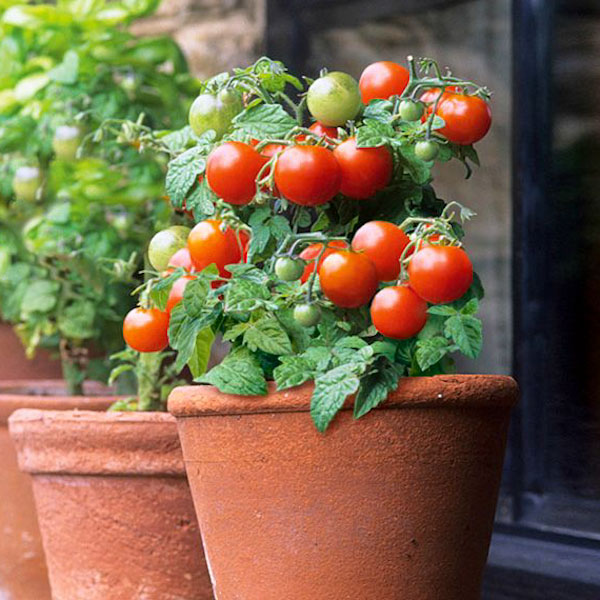
At the end of the summer season, move dwarf tomato bushes to the kitchen
Trees and bushes with appetizing fruits can also be found in living rooms. Among the most popular are lemon, pomegranate, fig, dwarf tangerine, avocado. Actually, experiments with planting exotic plants from seeds continue and soon they can be called indoor plants.
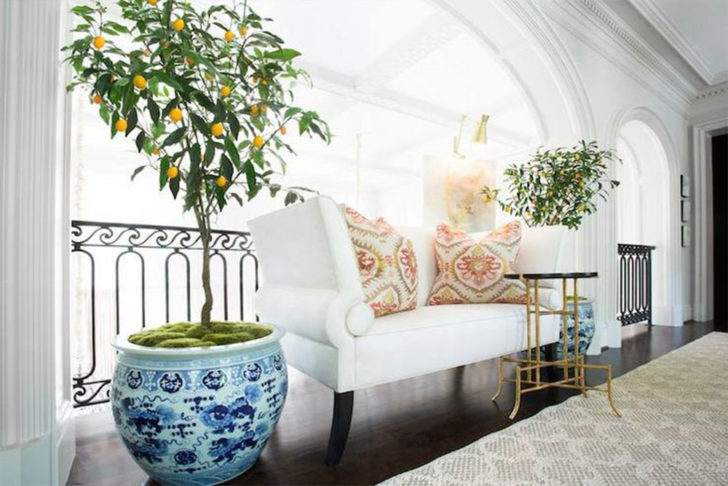
The lemon tree is increasingly seen in living rooms.
Plant hedges in the interior
Composition in a cache-pot
Indoor flowers are a new tool for zoning a room. The simplest and most effective division of functional areas comes down to installing large planters or flower racks between them. For this purpose, pots and stands on wheels are ideal.
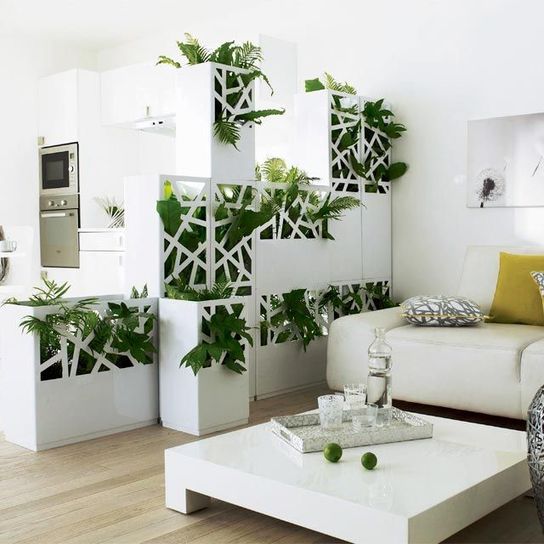
Zoning with flower racks
In this way, you can visually separate the kitchen from the dining room, the dining room from the living room. It is easy to allocate private spaces in the nursery “for two. Flower groups are placed so that they do not block the passage, but outline the boundaries. Large plants - palm trees, lemon, ficus - successfully cope with the role of a false wall.
Vertical green screens
A radical way to divide space is to install live partitions with vertical arrangement of plants. Their designs are varied, and such walls made of herbs, succulents, ivy or leafy plants look incredibly impressive.
Designers are in no hurry to introduce a glass block wall between the bathroom and the toilet in the combined bathroom into the project - instead of it, you can install a frame for vertical gardening. Water is nearby, moss or ampelous plants are easy to drink with moisture, and succulents will get enough of it even without watering. The problem of lighting is solved by supplementary lighting, but if the bathroom has a window, then there will be no shortage of lighting.
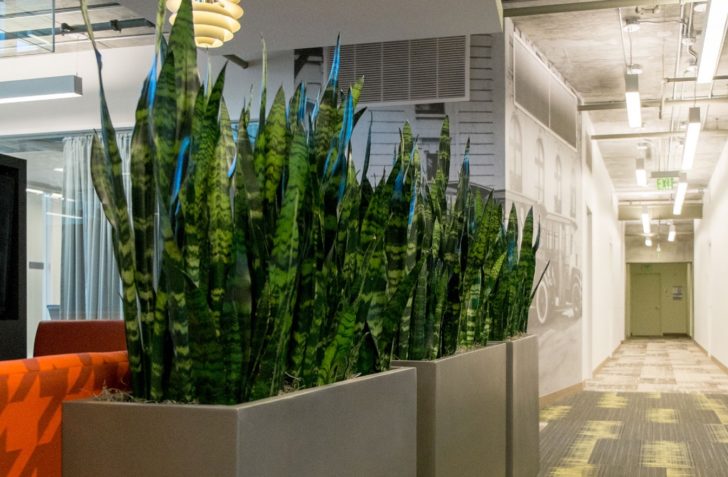
Living partition with vertical arrangement of plants
Such structures are built into interior partitions that separate the entrance and living room, bedroom and office. For a vertical greenhouse, not a single square meter of space is needed, because it is inscribed in the thickness of the wall.
The inner garden wall is illuminated with lamps. First of all, it's incredibly beautiful. Secondly, additional lighting helps plants grow intensively and bloom magnificently.
back to index ↑How not to fall into slavery?
Proper care of indoor plants in a city apartment takes a lot of time. How to keep them in excellent condition and not spend half your free time on chores?
If plant growing has not become a favorite hobby, then it is necessary to select indoor flowers that develop well under the given conditions - with the available lighting, humidity, and temperatures. Limit the choice according to the principle of the simplest agricultural technology. Keep in mind that care for large and non-flowering plants is usually easier.
back to index ↑What to do incompetent?
If a person categorically does not know how to take care of fresh indoor flowers, then this is not a reason to abandon the "green" interior. There are alternatives:
- Cultivate succulents. It is enough to water them once every 1-2 weeks, but you can’t “fill in” - they will get sick.
- Mastering the forcing of bulbous flowers is not at all difficult.
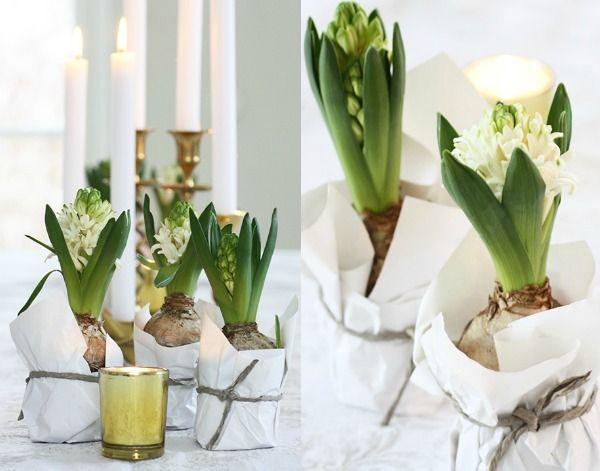
Master the forcing of bulbous flowers
- Install vertical and horizontal landscaping with automatic irrigation, mounted by professional florists.
- Order a panel made of stabilized moss - a living material that, as a result of processing, retains a fresh look for 5 years.
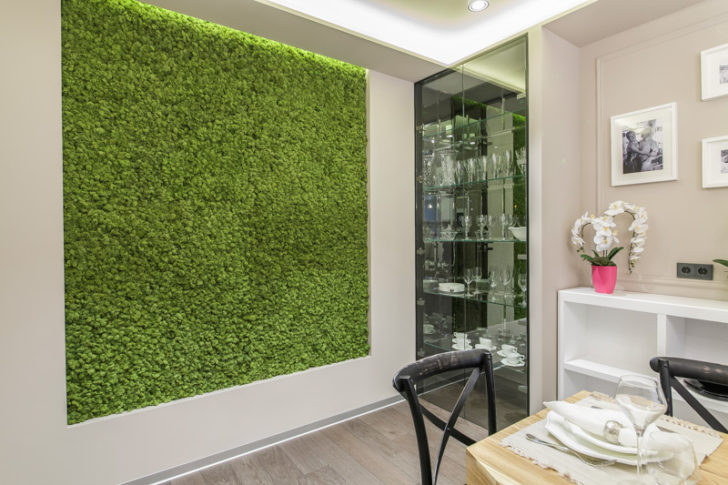
Stabilized moss panel
- Limit yourself to cut leaves and branches in vases with water. Monstera leaves, olive and eucalyptus branches can stand in water for 2-4 weeks.
- Use artificial plants - at some distance they cannot be distinguished from real ones.
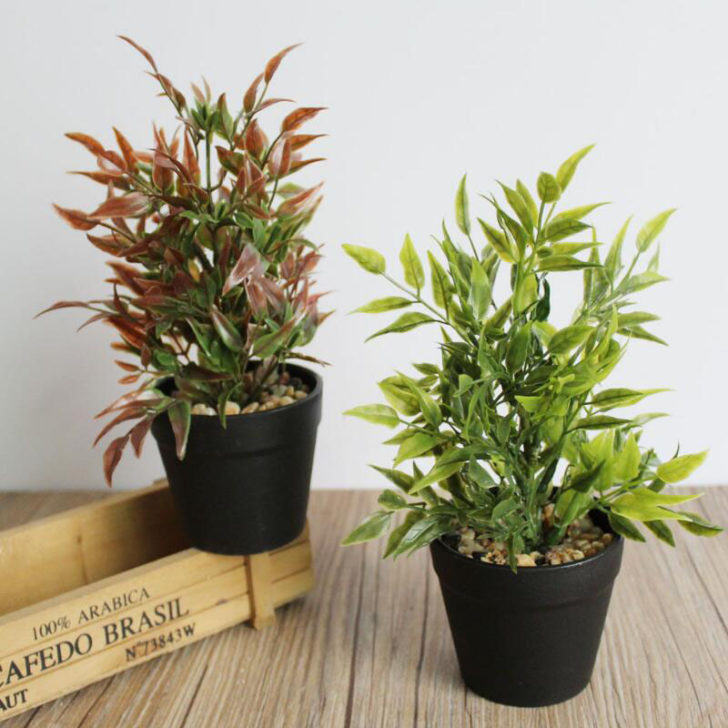
Quality artificial plants are indistinguishable from real ones
Fashion is tough. If you do not introduce indoor plants into the interior now, then in a year it will turn out that the chic design of the apartment, devoid of flowers and green areas, is hopelessly outdated.
back to index ↑Balcony landscaping
It would be strange to ignore balconies, loggias and terraces. The methods of their design were supplemented with novelties: mini-greenhouses, similar to bird cages, hanging planters placed along the entire height of the wall, and florariums.
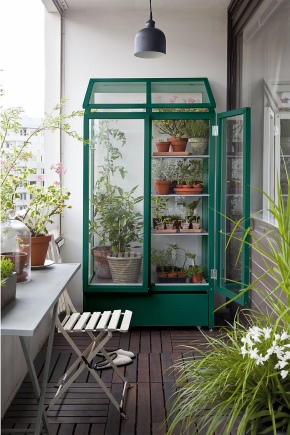
Mini greenhouse on the balcony
Usually, in the phytodesign of the balcony, they adhere to the same style as in the interior of the apartment.
back to index ↑What surprised us designers in 2018
Summing up the fashionable review of floral design in the interior, we highlight the novelties, discoveries and the most important trends.
- An interior without plants is not modern.
- There are not many plants.
- Autonomous closed phytosystems have opened a new era in apartment design.
- Phytowall with automatic irrigation is the main find of 2018.
- Florariums and microgreenhouses are favorites of designers.
- The most sudden technique is growing plants upside down.
- Moss has come to interior design.
- The most fashionable ornamental plants in the interior are poisonous.
- Stabilized plants do not differ from real ones, do not need care, last 5-6 years.
- Artificial flowers are, it turns out, stylish.
- A cut leaf in a vase competes with a bouquet of flowers.
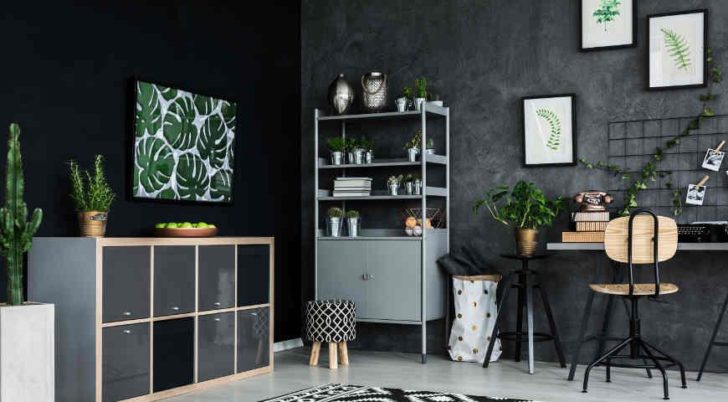
It is hard to imagine a modern interior without plants.
When a new wave floods into fashion, the recommendations of designers are full of categoricalness, and conceptual models are exaggerated. This is the law of the genre: in order to accept the new, one must survive the shock.
Subsequently, everything will become more democratic and harmonious, but so far, at the break of fashion trends, we have found ourselves under a kind of pressure: either we urgently need to select plants for the interior, or we will have to join the ranks of retrogrades.
However, compromise solutions have already been proposed, and choosing your own style is perhaps the most interesting thing in the world of fashion.
back to index ↑Photo gallery - indoor plants in the interior
Video
